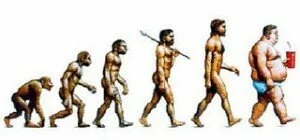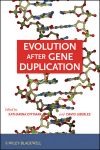 The famous phrase has it that evolution is a process of the “survival of the fittest.” However, it should be noted that this doesn’t imply some great evolutionary gymnasium, with species pumping and sculpting themselves into the most sexually appealing shapes of the day. Rather, the phrase means something more like “the survival of the aptest”—that is, that those whose bodies are genetically best “fitted” to their environment are those who are most likely to survive and to pass their extra-suitable genes on to future generations.
The famous phrase has it that evolution is a process of the “survival of the fittest.” However, it should be noted that this doesn’t imply some great evolutionary gymnasium, with species pumping and sculpting themselves into the most sexually appealing shapes of the day. Rather, the phrase means something more like “the survival of the aptest”—that is, that those whose bodies are genetically best “fitted” to their environment are those who are most likely to survive and to pass their extra-suitable genes on to future generations.
Recent research has brought this distinction very much to life for humans living in the sugar- and fat-rich developed world, one in which burger joints and donut shops are often found on every other block. In what is, in evolutionary terms, a brand new environment, genetic adaptations that were essential for early human survival—those designed to preserve as much fat and energy as possible—are now perhaps major contributing factors in making many of us unfit. Here are two mutations that may be implicated in the conditions of obesity and diabetes.
CMAH
In mammals, the CMAH gene codes for an enzyme responsible for adding oxygen atoms to sialic acids, thus creating sugars that coat cells’ membranes. However, about 2-3 million years ago, the CMAH gene in humans underwent a mutation, rendering the enzyme inactive. The result, according to a recent study from UCSD, 1 is that obese individuals end up being more prone to type 2 diabetes than they would if the gene were still intact.
To study the effect of mutated CMAH genes, Jane Kim and her colleagues developed a mouse model that mimicked the human defect in the CMAH gene. They then compared two groups of mice: one with a functional CMAH gene, and one with the human-like mutated CMAH gene. When fed a high-fat diet, both groups of mice became obese and developed insulin resistance. However, only the mice with the CMAH gene mutation experienced pancreatic beta cell failure. Pancreatic beta cells normally make and release insulin, a hormone that controls blood sugar levels. This blood sugar impairment may help to explain why obese humans are particularly prone to develop type 2 diabetes.
GIP
The GIP gene codes for a protein that stimulates insulin production in humans after eating a meal. However, a certain genetic variation—identified by Sheau Yu Hsu of Chang Gung Memorial Hospital and fellow researchers at Texas A&M Univeristy2—results in certain human populations having higher fasting levels of blood glucose than those with the older, more ancestral form of the gene—thus rendering them more prone to developing diabetes.
Hsu and his colleagues chose to study the GIP gene variant by looking through 207 genetic regions that have been associated with diabetes or obesity and determining which regions have increased in prevalence since humans began migrating out of Africa about 60,000 years ago. They then used Hapmap—a catalogue of genetic variations among global populations—to find genes that show frequently occurring variations in Asians and/or Europeans but not in Africans.
To compare the ancestral form and the newer variant of the GIP gene, Hsu’s group then selected an even narrower population: pregnant women. They found that out of approximately 120 East Asian pregnant women, those who carried two copies of the newer genetic variant had significantly lower levels of GIP in their blood. This implies that they produced less insulin, leaving them at risk of maintaining unhealthily high blood glucose levels—a condition which ultimately results in type 2 diabetes.
Why were these genetic mutations carried through the human population?
According to Hsu, “These gene variants and the resulting higher blood sugar levels may have helped women maintain successful pregnancies in the face of inevitable famines that occur in an agriculturally based society.” Furthermore, certain genetic variants that increase the risk of diabetes also decrease risk of certain diseases and infections.3
Back in a time when the risks of dying from untreatable illnesses or starvation far outweighed the dangers of diabetes, these variants were favorable. However, with the advent of modern medicine and industrialized agriculture, diabetes has become the more dire concern. The challenge now is to identify which variations have left us more prone to conditions such as obesity and diabetes—and then to find solutions.
| Resources from Wiley on This Topic | |

|
Evolution After Gene Duplication
by Katharina Dittmar and David Liberles |

|
Evolution: A Developmental Approach
by Wallace Arthur |

|
Human Bioarchaeology of the Transition to Agriculture
by Ron Pinhasi and Jay T. Stoc |
1. Kavaler, S., Morinaga, H., Jih, A., Fan, W., Hedlund, M., Varki, A., & Kim, J. (2011). Pancreatic -cell failure in obese mice with human-like CMP-Neu5Ac hydroxylase deficiency The FASEB Journal DOI: 10.1096/fj.10-175281
2. Chang, C., Cai, J., Cheng, P., Chueh, H., & Hsu, S. (2011). Identification of Metabolic Modifiers That Underlie Phenotypic Variations in Energy-Balance Regulation Diabetes, 60 (3), 726-734 DOI: 10.2337/db10-1331
3. Corona, E., Dudley, J., & Butte, A. (2010). Extreme Evolutionary Disparities Seen in Positive Selection across Seven Complex Diseases PLoS ONE, 5 (8) DOI: 10.1371/journal.pone.0012236
